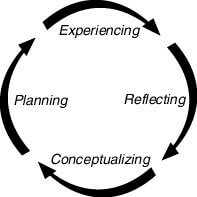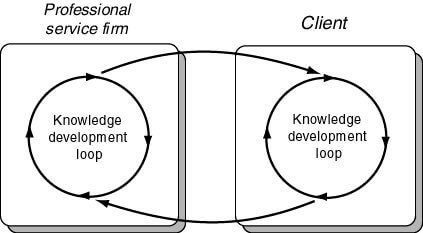Designing effective co-creation of knowledge using knowledge development loops
Last week I gave the opening keynote at the Chartered Accountants Australia New Zealand’s Thought Leadership Forum, the fifth consecutive year I have done the keynote for this excellent event series. My keynote was on The Potential of Business-Academic Collaboration, offering a big-picture view of the possibilities for value creation between university business faculties and the business sector.
As I was preparing my keynote it struck me that the themes of my first book Developing Knowledge-Based Client Relationships are extremely relevant here. Universities are implicitly knowledge-creating organizations, and the value they have to offer to the business sector must be in developing their knowledge capabilities.
Below is an excerpt from the book, describing the concept of ‘Knowledge Development Loops’. Kolb’s learning cycle is very instructive in this case, with Reflecting and Conceptualizing clear strengths of the academic sector, while planning and Experiencing are clearly at the heart of any effective business.
The concept of the knowledge development loop is that both (or all) organizations involved in the co-creation of knowledge must have their own learning cycle, but working with others they can emphasize their strengths in the collaborative learning process.
Of course in my keynote I communicated these ideas in a far more accessible manner, but I thought it was worth sharing the segment of the first edition of my book that describes this here.
Knowledge Development Loops
Excerpt from Chapter 8 of Developing Knowledge-Based Client Relationships First Edition.
The development of knowledge is an iterative process, in which experience and learnings provide the basis for deeper understandings in ongoing feedback loops. A loop-based framework for understanding learning and knowledge development was developed by David Kolb, and this still provides a foundation for much of our understanding of adult learning.
Kolb suggested that there are four phases in the learning cycle. The first is experiencing, which stems from doing and activity. The second phase is engaging in reflection on the experience, which is followed by conceptualization by interpreting the events and the relationships between them. The fourth stage is the planning of further action based on the learning, which brings it full cycle back to engage in further experience.3 This is illustrated in figure 8-1.

Figure 8-1
The learning cycle
The feedback loop as a foundation for knowledge development has also been applied to organizations. Nonaka and Takeuchi have suggested a knowledge spiral in organizational knowledge development, which goes successively through the phases of socialization, externalization, combination, and internalization, as shown in chapter 2, building from the level of the individual to that of the organization and beyond.
Knowledge feedback loops are at the heart of knowledge creation within organizations. While knowledge creation is by its nature iterative, how the loop functions will be different between organizations. Which part of the cycle is emphasized and the linkages between each phase will vary substantially. Understanding the nature and detail of this feedback loop provides insights into how to structure all knowledge transfer with clients.
Since the co-creation of knowledge involves at least two organizations, it is very valuable to understand the dynamics of the knowledge creation loop, not only within the client, but in your own organization. Figure 8-2 shows how the knowledge development loop within two individual organizations can be combined to become a shared process of creation and development between two organizations. This framework can be a valuable tool to help design effective collaboration processes. Once the differences and relative strengths of each phase of the knowledge development loops in each company are understood, they can then be combined into a inter-organizational knowledge development loop which best encompasses and uses the loops and strengths within each organization. This focuses attention on and helps define which elements of the knowledge creation cycle should be performed by each organization, and specifically what communication channels and content will maximize the richness of feedback and development.

Figure 8-2
The knowledge development loop within and between organizations
Image: Lance Shields



